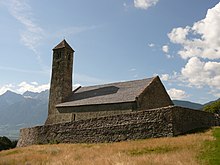Tartsch
Tartsch ( Italian Tarces ) is a fraction of the municipality of Mals in South Tyrol ( Italy ) with 506 inhabitants (as of January 2020) . The village is located at an altitude of 1029 m in the Vinschgau or Vinschger Oberland on the orographic left side of the Etsch Valley . The village is located above the valley floor between the Tartscher Bichl (also Tartscher Bühel ) and the slopes of the Sonnenberg , immediately southeast of Mals , the main town of the same name.
The Tartscher Bichl is the landmark of the Vinschger Oberland. Because of its special location, it was already inhabited in prehistoric times, which is confirmed by the excavation of a Rhaetian house. According to legend, there used to be a very rich city on the Bichl, which sank because of the vicious life of its residents.
Tartsch also includes the Lechtl and Gemassen farms above the village on the Sonnenberg, as well as the hamlet of Muntetschinig.
etymology
The name is certainly of pre-Roman origin, but its meaning is unclear. The first written testimony is “Tarzhes” in a document from 1160. Since a stag horn votive with a Rhaetian inscription was found on the Tartscher Bichl , Diether Schürr thinks it could be named after a Rhaetian personal name * tarχia (with reference to the proven Etruscan name tarχie ).
Muntetschinig goes back to * monte Tarcinica (Tartscher Berg).
Attractions
Church of St. Veit am Bichl
On the Bichl there is a Romanesque church from the 11th century, which is dedicated to St. Vitus . Inside you will find wall paintings, including (in the apse) a meander frieze with a beaded ribbon, two shield-armored sea monsters fighting with each other, a presumably bearded man blowing a crook horn; Line of apostles between saints; in the vault, Christ as judge along with evangelist symbols; in the window reveal volute tendrils with cruciferous flowers. The z. The frescoes, some of which are badly damaged, date from around 1200. On the north wall of the nave, two strips of pictures show the legend of St. Veit (1st half of the 16th century); the entire west wall is filled with a cycle of paintings from around 1520 (fragmented).
Parish Church of St. Andrew
The original late Romanesque / early Gothic building burned down in 1499; It was rededicated in 1503. The tower, still Romanesque with coupled arched windows, was later raised. The nave walls are probably also still Romanesque. The ribbed vault in the nave was built around 1500; the polygonal choir was added in 1527. There are various wall paintings outside (early 16th century), u. a. Christophorus, fragmented, Lamentation of Christ, figure of a saint with loincloth, surrounded by tools and implements, praying donor couple with coat of arms.
The furnishings (high altar, etc.) are mostly late baroque; Outstanding is a late Gothic wooden crucifix, probably by Jörg Lederer (around 1520) and Maria with Christ Child (mid 15th century) and holy water stone (marble, 16th century, base 15th century).
traffic
The SS 40 leads directly through the village and past the parish church. As a result, the village is practically divided into two parts and the Tartsch population suffers accordingly from the traffic. However, an underground route to bypass the town center is currently under discussion. It is not yet clear whether and when it will be realized.
Personalities
- Bernhard Mazegger senior (1798–1876), doctor, poet, tourism pioneer
Web links
- Tartsch on the website of the municipality of Mals
Individual evidence
- ↑ a b Diether Schürr: The Tartscher Bichl and the interpretation of place names in the Upper Venosta Valley . In: Austrian name research . tape 3 , vol. 36, 2008, pp. 53-83 ( academia.edu ).
Coordinates: 46 ° 41 ′ N , 10 ° 34 ′ E
